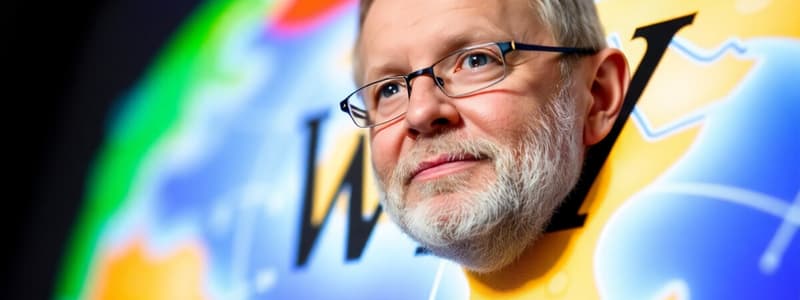Podcast
Questions and Answers
Which of the following best describes the significance of Tim Berners-Lee's ENQUIRE program?
Which of the following best describes the significance of Tim Berners-Lee's ENQUIRE program?
- It served as the foundation for the Large Hadron Collider's data processing system.
- It was adopted as the primary communication tool for CERN's internal staff, replacing existing methods.
- It demonstrated the potential for accessing documents over the internet, a precursor to the World Wide Web. (correct)
- It was the first commercially available software developed at CERN.
What key contribution did Tim Berners-Lee make to the World Wide Web that ensured its widespread adoption?
What key contribution did Tim Berners-Lee make to the World Wide Web that ensured its widespread adoption?
- He restricted access to the Web to academic institutions, ensuring its integrity.
- He developed a proprietary operating system that was required to access the Web.
- He patented the underlying technologies, ensuring a revenue stream for continued development.
- He provided the World Wide Web to the world for free, which promoted rapid global development and accessibility. (correct)
What role did CERN play in the development of the World Wide Web?
What role did CERN play in the development of the World Wide Web?
- CERN served as the location where Berners-Lee developed and launched the World Wide Web. (correct)
- CERN was solely a user of the Web after its creation, with no involvement in its initial development.
- CERN provided funding for Berners-Lee's research but did not directly contribute to the Web's development.
- CERN's primary contribution was providing hardware for the Mark I computer.
How did Tim Berners-Lee's early life experiences influence his later work on the World Wide Web?
How did Tim Berners-Lee's early life experiences influence his later work on the World Wide Web?
Which of the following reflects a challenge currently facing Tim Berners-Lee's vision for the World Wide Web?
Which of the following reflects a challenge currently facing Tim Berners-Lee's vision for the World Wide Web?
What was the state of the internet when Berners-Lee returned to CERN in 1984?
What was the state of the internet when Berners-Lee returned to CERN in 1984?
What key technologies were launched as part of the World Wide Web in 1991?
What key technologies were launched as part of the World Wide Web in 1991?
How did Tim Berners-Lee's program ENQUIRE anticipate the function of the World Wide Web?
How did Tim Berners-Lee's program ENQUIRE anticipate the function of the World Wide Web?
What was the primary reason Tim Berners-Lee decided to make the World Wide Web available for free?
What was the primary reason Tim Berners-Lee decided to make the World Wide Web available for free?
Which action did Tim Berners-Lee take immediately after the World Wide Web went live in 1991?
Which action did Tim Berners-Lee take immediately after the World Wide Web went live in 1991?
What are the main functions of HTML and HTTP in the context of the World Wide Web?
What are the main functions of HTML and HTTP in the context of the World Wide Web?
What contributed significantly to the rapid proliferation of the World Wide Web in the mid-1990s?
What contributed significantly to the rapid proliferation of the World Wide Web in the mid-1990s?
What is the primary role of the World Wide Web Consortium (W3C), founded by Tim Berners-Lee?
What is the primary role of the World Wide Web Consortium (W3C), founded by Tim Berners-Lee?
How did J.C.R. Licklider contribute to the development of the internet?
How did J.C.R. Licklider contribute to the development of the internet?
What was a key difference in approach between Tim Berners-Lee and traditional inventors regarding their creations?
What was a key difference in approach between Tim Berners-Lee and traditional inventors regarding their creations?
Why was the decision to make the World Wide Web available for free considered a generous act by Tim Berners-Lee?
Why was the decision to make the World Wide Web available for free considered a generous act by Tim Berners-Lee?
Flashcards
Tim Berners-Lee
Tim Berners-Lee
British computer scientist, inventor of the World Wide Web.
World Wide Web
World Wide Web
A multimedia library, workplace, and social space accessed via the internet.
ENQUIRE
ENQUIRE
A computer program created in 1980 to connect CERN academics and their projects.
Information Management: A Proposal
Information Management: A Proposal
Signup and view all the flashcards
World Wide Web Launch
World Wide Web Launch
Signup and view all the flashcards
2004
2004
Signup and view all the flashcards
CERN
CERN
Signup and view all the flashcards
Berners-Lee's vision
Berners-Lee's vision
Signup and view all the flashcards
Browser
Browser
Signup and view all the flashcards
Open access
Open access
Signup and view all the flashcards
HTML
HTML
Signup and view all the flashcards
HTTP
HTTP
Signup and view all the flashcards
W3C
W3C
Signup and view all the flashcards
August 6, 1991
August 6, 1991
Signup and view all the flashcards
J.C.R. Licklider
J.C.R. Licklider
Signup and view all the flashcards
Arpanet
Arpanet
Signup and view all the flashcards
Study Notes
- Tim Berners-Lee, a British computer scientist, invented the World Wide Web.
- The World Wide Web is a multimedia library, workplace, shopping center, and social space accessible via the internet.
- Berners-Lee set up the World Wide Web in 1991 and made it freely available to the world.
Key Milestones
- 1980: Berners-Lee wrote ENQUIRE, a computer program to connect CERN academics and their projects.
- 1989: Berners-Lee submitted a paper outlining a linked hypertext data system.
- 1991: Berners-Lee launched the World Wide Web at CERN, including HTML, HTTP, and the first browser.
- 2004: Berners-Lee was knighted by Queen Elizabeth II for contributions to the global development of the internet.
Early Life and Education
- Born in London in 1955, Berners-Lee demonstrated an early interest in computers.
- His parents were computer programmers at Ferranti, working on the Mark I, the world’s first general-purpose business computer.
- Berners-Lee attended Oxford University in 1973 to study physics.
- While at Oxford, he built his first computer using a second-hand television, logic gates, and a processor.
Career
- After graduation, Berners-Lee worked as a software engineer for British companies.
- In 1980, he joined CERN as a consultant.
- Berners-Lee conceived the idea that would transform global communication while addressing the communication needs of CERN's multilingual staff.
ENQUIRE Program
- In 1980, Berners-Lee created ENQUIRE to store information and track connections between people and projects at CERN.
- ENQUIRE demonstrated the potential for universal access to documents collected on the internet.
World Wide Web Proposal
- Berners-Lee proposed the World Wide Web in 1989 while at CERN.
- His proposal involved a program enabling users to access information via the internet using a browser
Open Access
- Berners-Lee advocated for CERN to make the World Wide Web freely available by placing it in the public domain.
- On April 30, 1991, the Web went live, and Berners-Lee published a manifesto with instructions for programmers to build their own websites.
Key Standards
- The first webpage outlined HTML (hypertext markup language) and HTTP (hypertext transfer protocol).
- HTML is a standard coding method for webpages, ensuring compatibility across different computers.
- HTTP is a language that enables web browsers to communicate with web servers storing websites in HTML.
Growth and Impact
- The simplicity of HTML and HTTP, along with the development of user-friendly web browsers, contributed to the rapid adoption of the World Wide Web.
- By the mid-1990s, millions of users, including individuals, universities, scientists, governments, and businesses, were actively using the World Wide Web.
World Wide Web Consortium (W3C)
- In 1994, Berners-Lee established the World Wide Web Consortium (W3C) to develop the Web’s open standards.
- Berners-Lee has consistently promoted a fair, democratic, and universally accessible Web for the benefit of everyone.
J.C.R. Licklider
- Licklider (1915-1990) was an early advocate for computer power
- From 1962, he was Head of Information Processing at ARPA.
- He commissioned Arpanet in 1963 which linked research computers.
- Data transfer procedures were fixed by 1978, and made compulsory by 1983, effectively creating the internet.
Studying That Suits You
Use AI to generate personalized quizzes and flashcards to suit your learning preferences.





